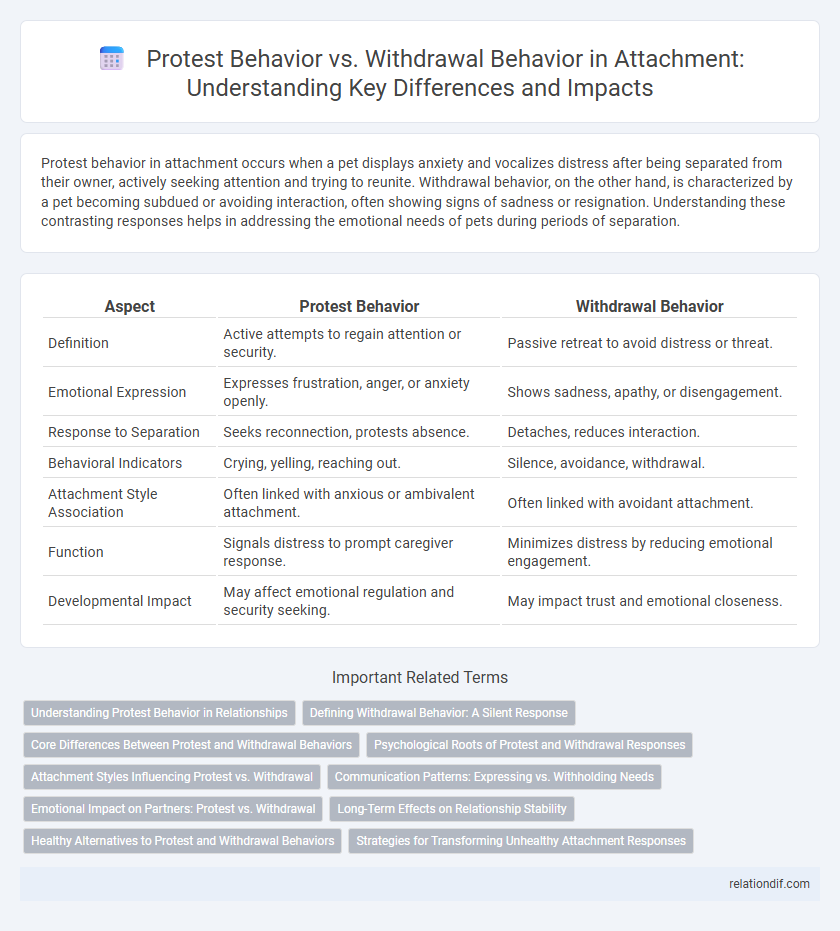Protest behavior in attachment occurs when a pet displays anxiety and vocalizes distress after being separated from their owner, actively seeking attention and trying to reunite. Withdrawal behavior, on the other hand, is characterized by a pet becoming subdued or avoiding interaction, often showing signs of sadness or resignation. Understanding these contrasting responses helps in addressing the emotional needs of pets during periods of separation.
Table of Comparison
| Aspect | Protest Behavior | Withdrawal Behavior |
|---|---|---|
| Definition | Active attempts to regain attention or security. | Passive retreat to avoid distress or threat. |
| Emotional Expression | Expresses frustration, anger, or anxiety openly. | Shows sadness, apathy, or disengagement. |
| Response to Separation | Seeks reconnection, protests absence. | Detaches, reduces interaction. |
| Behavioral Indicators | Crying, yelling, reaching out. | Silence, avoidance, withdrawal. |
| Attachment Style Association | Often linked with anxious or ambivalent attachment. | Often linked with avoidant attachment. |
| Function | Signals distress to prompt caregiver response. | Minimizes distress by reducing emotional engagement. |
| Developmental Impact | May affect emotional regulation and security seeking. | May impact trust and emotional closeness. |
Understanding Protest Behavior in Relationships
Protest behavior in relationships manifests as active efforts to regain closeness and attention when attachment needs feel threatened, often through vocal expressions of distress or persistent attempts to reconnect. This behavior contrasts with withdrawal behavior, where individuals retreat or disengage to protect themselves from perceived rejection or emotional pain. Understanding protest behavior highlights its role as a natural attachment response aiming to restore emotional security and maintain relational bonds.
Defining Withdrawal Behavior: A Silent Response
Withdrawal behavior in attachment theory is characterized by a silent and passive response to relational stress, where individuals disengage emotionally or physically to avoid conflict or discomfort. Unlike protest behavior, which involves active expressions of distress and attempts to reestablish connection, withdrawal manifests as reduced communication, avoidance, and internalized coping. This silent retreat serves as a protective mechanism to maintain emotional distance and prevent further relational tension.
Core Differences Between Protest and Withdrawal Behaviors
Protest behavior involves active efforts to regain lost attachment by expressing distress through crying, clinging, or searching, highlighting an external focus on reestablishing connection. Withdrawal behavior, in contrast, indicates detachment marked by reduced emotional expression and social interaction, reflecting an internal coping mechanism to perceived unavailability. These core differences underscore protest as an engagement-driven response, while withdrawal represents emotional disengagement within attachment dynamics.
Psychological Roots of Protest and Withdrawal Responses
Protest behavior in attachment theory is rooted in the psychological need for proximity and security, often manifesting as increased vocalization and agitation when separation occurs. Withdrawal behavior reflects an avoidant coping mechanism linked to perceived unavailability or rejection from the attachment figure, leading to emotional detachment and reduced seeking of comfort. These responses originate from early caregiver interactions influencing internal working models that shape individuals' attachment strategies and stress regulation.
Attachment Styles Influencing Protest vs. Withdrawal
Attachment styles significantly influence how individuals exhibit protest versus withdrawal behaviors in relationships. Anxious attachment often drives protest behavior, characterized by persistent efforts to seek closeness and reassurance when feeling threatened. In contrast, avoidant attachment typically leads to withdrawal behavior, where individuals distance themselves emotionally to manage discomfort and maintain autonomy.
Communication Patterns: Expressing vs. Withholding Needs
Protest behavior in attachment is characterized by openly expressing needs and emotions to seek reassurance and maintain connection, reflecting an active communication pattern aimed at resolving distress. Withdrawal behavior involves withholding needs and suppressing emotional expression to avoid conflict or rejection, indicating a passive communication strategy that can lead to emotional distance. Understanding these contrasting communication patterns is crucial for addressing attachment-related challenges in relationships and promoting healthier emotional engagement.
Emotional Impact on Partners: Protest vs. Withdrawal
Protest behavior in attachment triggers heightened emotional distress in partners, often causing feelings of confusion, anxiety, and urgency to restore closeness. Withdrawal behavior, conversely, induces emotional distance, leaving partners feeling rejected, helpless, and uncertain about the state of the relationship. Both responses significantly impact relationship stability by influencing partners' emotional security and communication patterns.
Long-Term Effects on Relationship Stability
Protest behavior in attachment reflects efforts to maintain closeness and can temporarily increase relationship engagement but often leads to heightened conflict over time. Withdrawal behavior, characterized by emotional distancing, tends to reduce immediate tension but accumulates unresolved issues, undermining long-term relationship stability. Research indicates that persistent protest or withdrawal patterns predict increased risk of relationship dissolution and decreased relational satisfaction across years.
Healthy Alternatives to Protest and Withdrawal Behaviors
Healthy alternatives to protest and withdrawal behaviors in attachment dynamics include open communication, emotional regulation, and seeking social support. Individuals practicing secure attachment utilize assertiveness and problem-solving skills to express needs without aggression or avoidance. These adaptive strategies foster trust and connection, mitigating the negative impact of protest or withdrawal on relationships.
Strategies for Transforming Unhealthy Attachment Responses
Protest behavior in attachment often manifests as intense efforts to restore connection, including persistent calling or seeking reassurance, while withdrawal behavior involves emotional or physical distance to avoid perceived rejection. Transforming these unhealthy attachment responses requires strategies such as mindfulness to increase self-awareness, emotion regulation techniques to manage distress, and therapeutic interventions like cognitive-behavioral therapy to reframe negative beliefs about oneself and others. Developing secure attachment patterns fosters healthier communication, resilience, and relational stability over time.
Protest behavior vs withdrawal behavior Infographic

 relationdif.com
relationdif.com